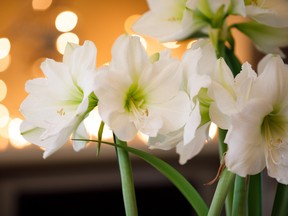Published Dec 24, 2024 • Last updated 1 day ago • 3 minute read

Houseplant lovers have a love-hate relationship with poinsettias, amaryllises and the other blooming plants that fill plant store shelves this time of year. For inevitably, just a few weeks later, they turn into Charlie Brown’s Christmas tree: they drop their leaves and wilt, the very picture of the February blahs.
Don’t beat yourself up – it’s not you, it’s the plant. With some notable exceptions (as we explain below), many popular Christmas houseplants have been specially bred to put on a spectacular show for a few weeks, then fulfill their destiny on the compost pile.
Advertisement 2
THIS CONTENT IS RESERVED FOR SUBSCRIBERS ONLY
Subscribe now to read the latest news in your city and across Canada.
- Exclusive articles from Elizabeth Payne, David Pugliese, Andrew Duffy, Bruce Deachman and others. Plus, food reviews and event listings in the weekly newsletter, Ottawa, Out of Office.
- Unlimited online access to Ottawa Citizen and 15 news sites with one account.
- Ottawa Citizen ePaper, an electronic replica of the print edition to view on any device, share and comment on.
- Daily puzzles, including the New York Times Crossword.
- Support local journalism.
SUBSCRIBE TO UNLOCK MORE ARTICLES
Subscribe now to read the latest news in your city and across Canada.
- Exclusive articles from Elizabeth Payne, David Pugliese, Andrew Duffy, Bruce Deachman and others. Plus, food reviews and event listings in the weekly newsletter, Ottawa, Out of Office.
- Unlimited online access to Ottawa Citizen and 15 news sites with one account.
- Ottawa Citizen ePaper, an electronic replica of the print edition to view on any device, share and comment on.
- Daily puzzles, including the New York Times Crossword.
- Support local journalism.
REGISTER / SIGN IN TO UNLOCK MORE ARTICLES
Create an account or sign in to continue with your reading experience.
- Access articles from across Canada with one account.
- Share your thoughts and join the conversation in the comments.
- Enjoy additional articles per month.
- Get email updates from your favourite authors.
THIS ARTICLE IS FREE TO READ REGISTER TO UNLOCK.
Create an account or sign in to continue with your reading experience.
- Access articles from across Canada with one account
- Share your thoughts and join the conversation in the comments
- Enjoy additional articles per month
- Get email updates from your favourite authors
Sign In or Create an Account
or
Article content
With some effort – in some cases, a lot of effort – it is possible to coax these plants into dormancy, nurture them over the summer and (conceivably) get them to rebloom next year. But here’s my recommendation: admire and care for them now, then when they start to fade, send them to Plant Heaven and look forward to beautiful new fresh ones next year.
Poinsettias
With their showy red, pink, salmon, cream or marbled bracts atop rich dark green foliage, these Mexico natives are a true symbol of the season. While in “bloom” (technically, the actual blooms are those little yellow berry-like things in the centre of the bracts), they make stunning houseplants. And contrary to popular belief, they are not poisonous to humans or pets.
But like many beautiful creatures, poinsettias can be temperamental. They like consistently moist but not soggy soil, and hate drafts of any kind. With care, they can last for several weeks or even months, but once they start dropping their leaves in earnest, it’s time to say goodbye.

Amaryllis
After poinsettias, amaryllises are pretty much the top-selling winter indoor plant. With two or more sturdy two-foot high stalks, each producing as many as four giant, trumpet-like red, pink, white or striped blossoms, they’re like a touch of the tropics in our homes.
Advertisement 3
Article content
You can buy the bulbs by themselves, but they’re more commonly sold in kits, with potting soil and a 6” pot. As soon as possible after you buy it (or unwrap it as a gift), plant the bulb about two-thirds deep, give it a good watering and place it on a sunny, draft-free windowsill. (If the flower stalk starts to flop over, support it with a plant stake.) Cut or snap off the blossoms as soon as they fade.
Paperwhites
These daffodil cousins are also often sold in kits or already planted and ready to go. When in full bloom, they’re like spring in a pot – with a strong fragrance that’s not to everyone’s liking. As with other potted bulbs purchased this time of year, you can plant them in the garden in spring (allowing the leaves to grow and die down naturally), but the results are usually not very promising.
Cyclamen
Cyclamens always remind me of the Greek Isles, where they grow wild on hillsides. These compact plants feature attractively patterned blue-green leaves and waxy, long-lasting blooms in red, pink, white or mauve. And in contrast to the other varieties mentioned here, you actually can keep them going, with at least a little less effort than some other winter-flowering plants.
Advertisement 4
Article content
Cyclamens go into dormancy around April. But, like Monty Python’s Norwegian Blue parrot, they’re not dead, they’re just sleeping. Continue to water sparingly over the summer, and by late fall, you may see green tips emerge again.
Christmas Cactus
Christmas cactus wins the award as the easiest and possibly longest-lived Christmas plant. As with most succulents, as long as you don’t overwater it, it will withstand considerable neglect and keep on going. There are stories of specimens passed on from grandmothers to grandchildren that continue to thrive.
Under the right conditions, bright red, cheerful blooms appear at the tips of its “branches” around Christmastime (inspiring its common name).
Recommended from Editorial
-

How to paint a room: Crucial considerations before picking up a brush
-

Top meal kits that make dining simple and delicious
Article content
.png)
 2 weeks ago
11
2 weeks ago
11




































 Bengali (BD) ·
Bengali (BD) ·  English (US) ·
English (US) ·